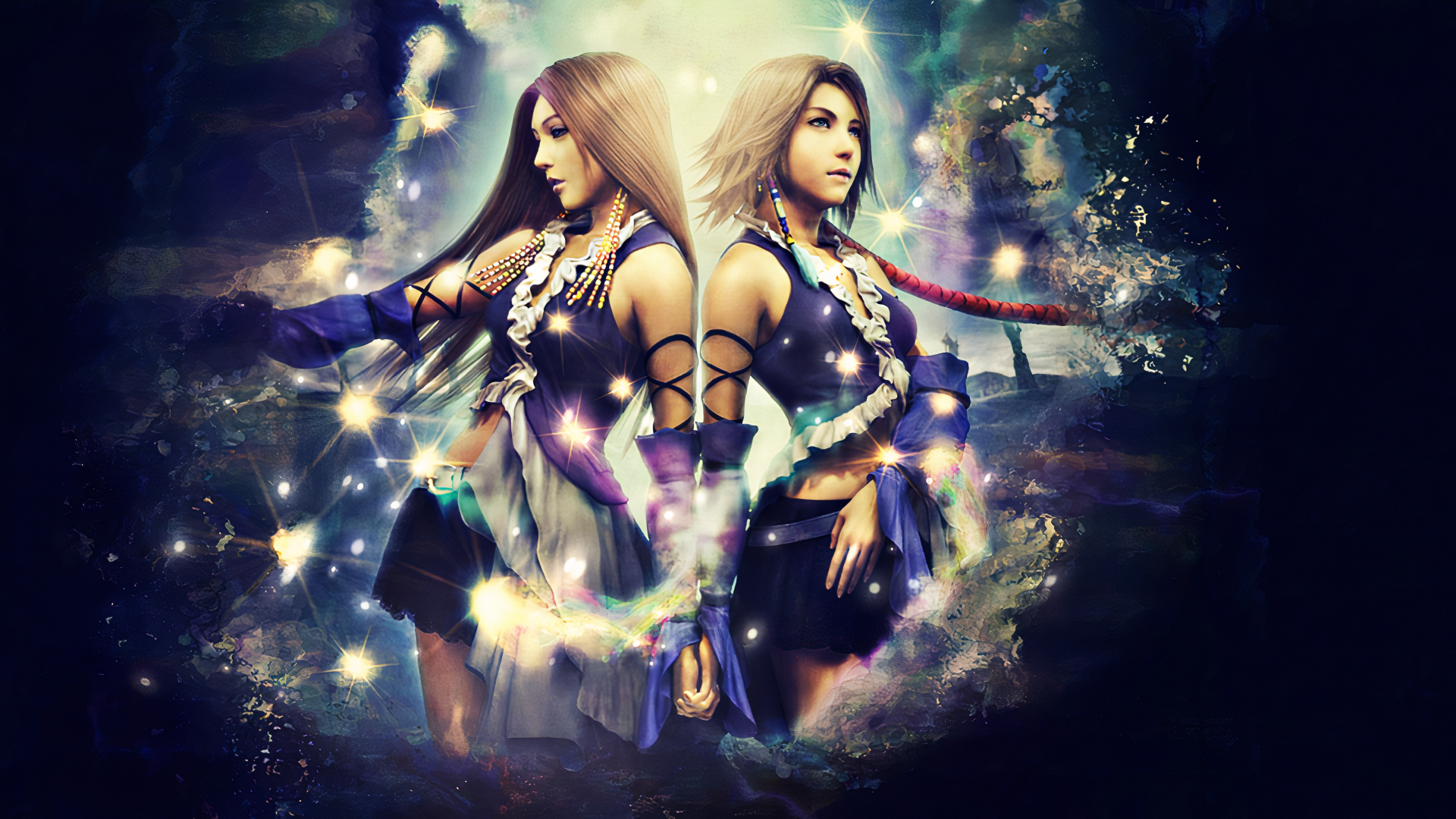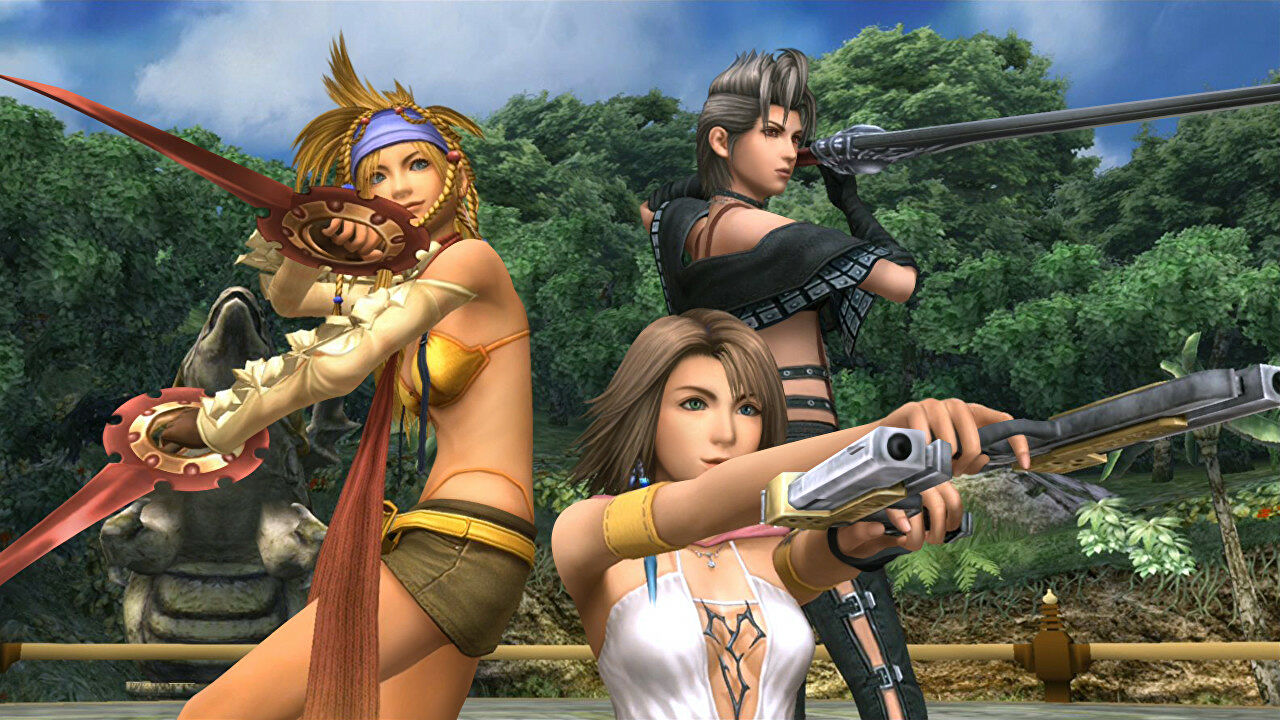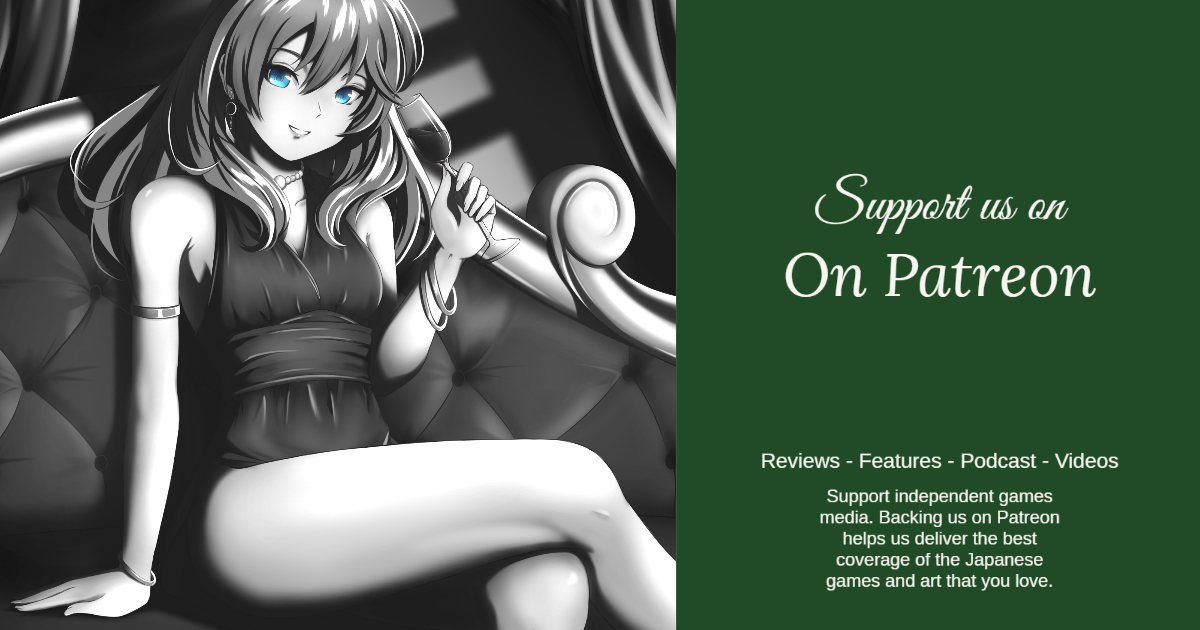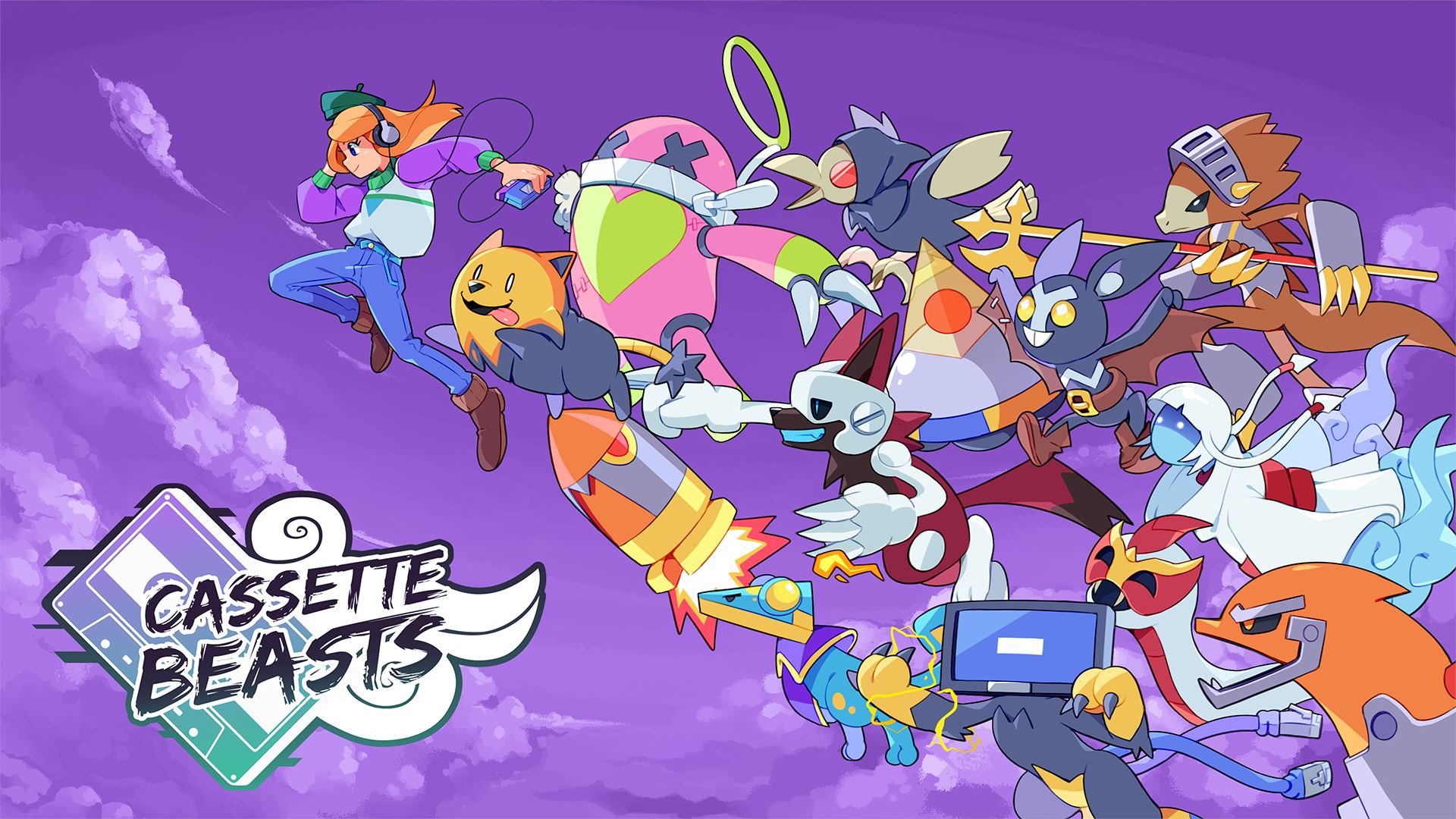“Oh! Rikku’s wearing a bikini! It’s bright yellow and it’s a THONG!”
Looking at Final Fantasy X-2 now, with its PlayStation 2-era fuzzies and jaggies, it’s hard to believe that it was once right up there with the most controversially fanservicey things out there. I remember the discussions that raged on the bulletin boards in the pre-social media Internet. For many, the response was simple: how dare Square Enix take something so precious as Final Fantasy X and make a sequel in which they slapped Yuna, the conservative, sweet, religious damsel/heroine, into the tightest denim shorts possible, and then make her backside, barely constrained by those shorts, the lead promotional image for the game?
Review: Our review of the Final Fantasy X and X-2 HD remaster.
For me, the image of THAT cut-scene of Rikku stripping out of her wetsuit in FFX burned permanently into my brain, getting to actually see her in a bikini in FFX-2 was a tease finally realised, and that was much more interesting than arguing in those debates. But I digress. Final Fantasy X-2, released just two months after the original Dead or Alive Beach Volleyball (we’ve reviewed the most recent one of that series here), certainly seemed to be likewise aligned, in that Japanese developers were seeing the success of Tomb Raider, realising they had some decent rendering power to work with now, and going all out to indulge the fantasies of the digitally-inclined. Sex sells, in other words. Most people at the time didn’t think much beyond that (and they still don’t).
The thing is, though, Final Fantasy X-2 wasn’t actually doing bikinis and hotpants for the heck of it. To this day, despite the many re-releases, this isn’t really that understood, nor written about, but Square Enix was using the fan service in a meaningful, interesting way. Consequently, Final Fantasy X-2 might just be the most misunderstood Final Fantasy of them all.
From religion to… well, religion
To understand the fanservice in Final Fantasy X-2, we first need to think about its predecessor. What was the main thematic purpose of Final Fantasy X? What was the massive, overarching theme that, even if you weren’t inclined to pull the script apart word for word, you’re going to walk away from the experience thinking about? It’s simple, of course. It’s religion. Through the motif of Yevon, and the deep faith of everyone the party encountered, Final Fantasy X was a dive into the sociocultural role of organised religion, both the positive role that it can have on communities, and the many ways it could be perverted and corrupted.
At the end of Final Fantasy X, it was pretty clear that the unquestioned power of the church and religion had been broken. Among the many consequences of that game’s conclusion, we knew that the world of Spira would recover with a very different understanding of faith – if it was going to have a sense of faith at all.
This is where the opening chapter of Final Fantasy X-2 comes in. In a world that no longer needs religion, what’s a former religious symbol – an enormously pretty one, at that – supposed to do? Well, become a pop idol, of course. The opening scene of Final Fantasy X-2 highlights that Yuna, Rikku and new girl, Paine, have formed a pop group, and now tour the world performing concerts rather than sending rituals. They’re so celebrated that they even have to deal with copycat acts! If you’ve ever seen how Japanese idols dress and perform, all of this costuming starts to make sense – it’s entirely appropriate for a Japanese entertainment scene that has fostered the likes of AKB48 (bikini photoshoots and all), superstars like Namie Amuro, and gravure fashion – sex is a big part of the appeal.
As you dive deeper into the game, it becomes pretty clear that pop music has become the new religion. Efforts to reform the church of Yevon struggle, and there’s a materialism that is running through society that has changed the texture of the culture. Where the teachings of Yevon drove a “dark ages” in Final Fantasy X and resistance towards progress, now society is embracing formerly banned technologies. Square Enix is careful to not take sides, making the reformist church one that players can sympathise with, but it is clear that the thematic thrust here is that people still need to fill their lives with something, and in the absence of piety, society instead seeks to elevate its own to the same pedestal – i.e. it begins to worship celebrity.
The accessible celebrity
As noted in an essay by Yuya Kiuchi (2017) titled: “Idols you can meet: AKB48 and a new trend in Japan’s music industry,” the unique qualities of the Japanese concept of celebrity make this theme particularly poignant, and perhaps explain why the idea is less explored in the writings about the game in the west: we’re just not used to seeing things done this way. Here, celebrities are aspirational – gossip magazines give us the chance to live vicariously through them because we can’t experience that ourselves.
In Japan, there’s the expectation that celebrities are approachable, and that fans can be personally involved in building their chosen celebrity’s success. “AKB48, a Japanese idol group with over 130 young female singers, presents a new trend in the entertainment industry,” Kiuchi writes. “It is a trend that is seemingly more democratic, but that creates and takes advantage of passionate and sometimes obsessive fans in a unique way…. This article discusses questions about the young singers’ individuality and agency as they function as significant drivers of a massive marketing machine. Such questions especially arise with cases of intra-group competitions and hierarchy, violence against and around AKB48, and the dating scandals involving group members.”
I see a very clear parallel between the fervent fandom of a group like AKB48 and a religion. These are people that will buy caseloads of the same CDs each year not for the music, but for a chance to vote for their favourite girl as the “#1 ranked AKB girl,” which is not dissimilar to showing faith by tithing. Similarly, the AKB48 girls are strictly forbidden from dating, much less having sex. When one girl in one of these groups was caught with a boy, she was pressured into shaving her head in a great show of apology to the fans. That’s little different to the way that religious leaders across most faiths are meant to be abstinent and focused on their relationship with whatever God they favour and their flock (essentially, fans).
And, just like highly religious people tend to go out into the community and influence it according to their faith, so too do fans of these groups form communities and host events, and can become very hostile towards those that they see as threatening to their societies. Including, at times, individual girls within the groups themselves.
So, again, we can see that Final Fantasy X-2 is making the very clear point that in the world of Spira, following the gaping hole left by the immediate dismantling of the church, the people replaced that with a new, human idol-driven faith. The game is not inherently supportive of this, but it’s making the point and opening the door for the discussion – the idol culture is strongly criticised within Japan by some groups, and the creatives working on FFX-2 were clearly cognizant of that.
And so we can see that in Final Fantasy X-2, it is absolutely essential that Yuna, Rikku, and Paine are dressed up in skimpy, sexy things. That’s part of the parallel that the game is making to the kind of post-religious society that characterises modern Japan. Sure, Japan is still dotted with many shrines and temples, but those are increasingly history and cultural tourism destinations within Japan for the Japanese themselves, rather than places of sincere faith. The unique idol and celebrity culture within Japan, as demanding and problematic as it can be for both celebrity and their fan base, is very much the modern faith for the culture. Yuna, Rikku and Paine needed to look the part in Final Fantasy X-2 for that theme to come across.
And Rikku really does look spectacular in that yellow bikini. I’ll not deny that’s not a big-time bonus. See? Fanservice can be both fun and make a point.
Note: This article was originally published in the July 2021 issue of the Dee Dee Zine. Since we are no longer publishing that magazine we’ve republished it here for posterity.















I got this on the switch, Japanese version, that comes region free, and everything included on the cartridge. I am currently playing through Last Mission for the first time, lol. FFX2’s story gets a bad rep, but the gameplay is deep, beyond the dressup look. I love perky Yuna and her long braid, lol. I did not like Paine at first, but I she grew on me. I think Lightning From FFXIII was based off her. Considering the Synergy battle system in XIII, It seems like it was inspired from FFX2’s battle system. You know flip changing on the fly, haha.